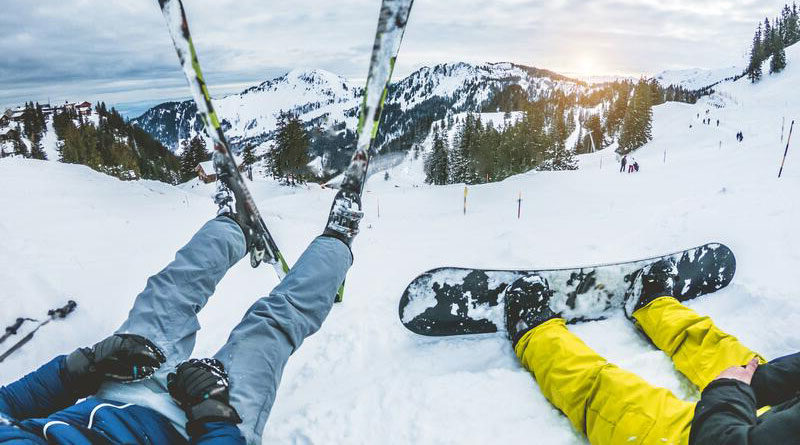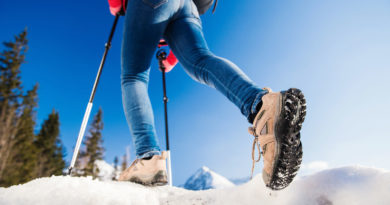Ski vs. Snowboard Boots: A Comparison
Skiing and snowboarding are completely different, although, both are classified as snow sports and both use the same resorts. Both of these sports use different types of lower-body movements. Of course, the gear of the two sports also has to be different then.
While other pieces of gear like skis and snowboards are obviously different, many people ask what’s the difference between ski and snowboard boots. Both of these boots are completely different and both serve a different purpose. The only thing common about the two kinds of boots is that they both require bindings to attach to their respective snow gliding gear.
This guide explains in detail how the two types of boots differ from each other.
Shell
Ski and snowboard boots can easily be recognized by their outer shells. Skiers are even easier to recognize by looking at the way they walk, even if they are not holding their equipment. Ski boots are made of hard plastic or composite shell. The hard construction of the ski boot protects the ankle and the feet.
The shell of the ski boots also has visible attachment points for ski bindings. Due to their rigid construction, ski boots are extremely uncomfortable to walk in. That’s why you would see a lot of skiers running back to their lockers to change their boots once they are done skiing.
Snowboard boots, on the other hand, look just like normal boots at first glance. Their shells are made of softer material compared to ski boots. Snowboard boot shells are usually made of flexible leather along with other synthetic materials.
There are no special cutouts on the boots to attach to snowboard bindings. The softer construction of the snowboard boots makes them easier to walk in compared to ski boots. But that doesn’t mean you can go on long strides in your snowboard boots. They are still rigid. However, it does allow you to perform tricks easily with snowboard boots.
Rigidity brings us to another similarity between the two types of boots. Both, ski and snowboard boots have a flex rating. Snowboard boots have a lower flex rating than ski boots. The flex rating of both boots is based on the skill level of the rider.
Tightening System
The systems used to tighten the two types of boots are also different from each other. Ski boots use buckle systems for tightening. A ski boot can have somewhere from a single buckle to four buckles. Single-buckle systems are rare in ski boots.
Two, three, and four-buckle systems are common. Beginner boots mostly have two or three-buckle systems while boots for advanced users have four-buckle systems. Other than the buckles, ski boots also have a power strap at the top to secure the leg in its place.
Snowboard boots use three systems for tightening; traditional laces, quick lace system, and BOA system. BOA system can be single, double, or triple BOA. The traditional lacing system and double or triple BOA system allow for zonal tightening where you can tighten the upper and lower zones of the boots according to your liking. The quick lace system is convenient and fast but has no zonal tightening.
Outsoles
Ski boots are tricky when it comes to outsoles. The outsoles of ski boots are also called “norms”. There are many different types of norms in ski boots based on your use. But the three common norms that you will find in ski boots today are Alpine ISO 5355, Alpine Touring ISO 9523, and GripWalk.
There are other norms as well but they are not used by regular people or are being phased out with time. For example, the Non-ISO Alpine 5355 is used by professional athletes who customize it to their liking. The WTR (walk-to-ride) soles are being phased out.
Different types of outsoles mean you would have to be careful about choosing the right bindings. Otherwise, you would have compatibility issues.
Because snowboard boots don’t click in their bindings like ski boots, there is no norm system in snowboard boots. All boots fit almost all bindings and you don’t have to worry about compatibility issues. The outsoles of snowboard boots are made of rubber or synthetic material. Snowboard boots for park riding have extra cushioning to absorb landing impact while performing stunts.
Bindings
Both, ski and snowboard boots attach to skis and snowboards respective using their respective bindings. The bindings used by both boots are completely different from one another.
The bindings for ski boots are more complex than snowboard bindings. They use different technologies like an anti-friction device, different dampening systems, release systems, etc. But they are much easier to use.
Ski bindings use a click system to simply click your boots to the skis. You can do this easily while standing and the bindings have brakes to keep the skis in their place. To release, you simply unclick your boot based on your release force and your skis are released easily and quickly.
But when it comes to compatibility issues with ski bindings, there are a lot. Not only do you have to be careful about the norms of the ski boots but also about the width and length of the skis.
Snowboard bindings are simpler compared to ski bindings. But not as simple as the previous statement makes them sound. Snowboard bindings also have dampening systems and other technologies to improve the riding experience.
But most snowboard bindings feature a traditional strap system where you have to strap the boots in. With time, there have been many improvements to make the process faster and smoother but it is still not as easy as the click system in ski bindings.
If you want to fit or release your boots from the bindings, you would have to sit and manually do it. Snowboard bindings also introduced a click-in system but it didn’t gain popularity. However, you don’t have many compatibility issues with snowboard bindings. All you have to look for are bindings or boards that attach with each other.
Conclusion
There are major differences between ski and snowboard boots. With these differences, it is obvious that you can’t use the same boots for both sports. You would have to change the boots for both of these sports.




